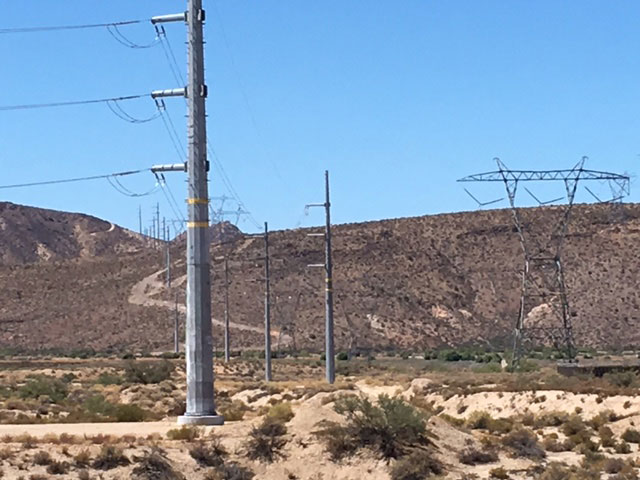Wildfire Dangers of High-Voltage Transmission Lines

^High-voltage transmission lines near Jacumba in the eastern San Diego backcountry.
January 28, 2019 - We have supported better Distributed Energy Resources and policy for ten years now, as the better alternative to bulldozing desert ecosystems and public lands wild areas.
Now, the Camp Fire has revealed some of the under-appreciated benefits of pairing residential and local solar systems with battery storage in local grid areas in load centers. Instead of long high-voltage transmission lines from remote power stations (such as those far out in the desert), crossing wildlands with forest and brush fuels.
The Los Angeles Times has detailed how potentially 2,000 wildfires have been ignited by utility transmission and electrical equipment in California.
Those claiming Distributed Generation (DG) such as rooftop solar is too expensive comp ared to remote utility-scale solar and wind projects, are not taking into account the benefits that should be priced in to DG that does not need expensive transmission lines stretching often hundreds of miles (and which ratepayers pay for).
PG&E, after claims of their transmission equipment sparking the Camp Fire last year--the most deadly wildfire in California history, says it cannot afford the insurance, liability, and litigation, and will undergo Chapter 11 bankruptcy filing supposedly this week. A U. S. District Court judge ordered the Investor Owned Utility to plan and fund a gigantic transmission inspection and vegetation clearing from around their transmission infrastructure--a plan which PG&E said it could not afford. High winds knocking tree branches onto wires is apparently a big problem.
The large northern and central California utility's bankruptcy calls into question existing Power Purchase Agreements, including Topax Solar Project in Carrizo Plain, and a unit of the Ivanpah Solar Electric Generating System. We will be watching to see what happens.
Ten West Link Transmission Project
March 26, 2016 - Public scoping meetings for the Ten West Transmission Project (partially running through the Kofa National Wildlife Refuge) have been scheduled but still not announced by the Bureau of Land Management. Here are the scheduled meetings:
Tuesday, April 12, 2016
5:30 – 8:00pm
Ruth Fisher Elementary School
Cafeteria
38201 W. Indian School Rd
Tonopah, AZ 85354
Wednesday, April 13, 2016
5:30 – 8:00pm
Quartzsite Senior Center
40 S. Moon Mountain Ave
Quartzsite, AZ 85346
Thursday, April 14, 2016
5:30 – 8:00pm
Blythe Community Center
445 N Broadway
Blythe, CA 92225
The deadline for comment is May 9, 2016.
The right-of-way through Bureau of Land Management land would be for a single-circuit 500-kV transmission line. Authorization of the proposed transmission line may require an amendment to the Yuma Field Office Resource Management Plan (January 2010) to change visual resource management classifications and to possibly change or reclassify designated utility corridors. The Project area involves approximately 83 miles of public lands along a route spanning roughly 114 miles. Approximately 97 miles is in Arizona and 17 miles is in California. The Project would largely follow the existing SCE Devers-Palo Verde 500-kV No.1 (DPV1) transmission line in an established utility corridor.
Here is the Federal Register announcement:
Transmission Line Truths
February 25, 2009 - Senate Majority Leader Harry Reid announced this morning he will introduce a bill that would give the federal government vast new authority to site electrical transmission lines in Nevada and other states.
Reid announced the pending legislation at the opening of the National Clean Energy Project in Washington. Former President Bill Clinton, former Vice President Al Gore, billionaire wind-energy promoter T. Boone Pickens, House Speaker Nancy Pelosi and others joined Reid at today’s summit.
At a similar forum in Las Vegas last summer, the development of transmission lines emerged as a key to expanding renewable energy.
Reid’s bill could grant the federal government eminent domain authority in establishing the transmission lines, Dow Jones reported this morning.
The federal authority could helping to speed what has been a lengthy process but it also faces potential political opposition from communities and lawmakers.
In the just-signed economic recovery package, $3.25 billion in new loan authority has been made available for the Western Area Power Administration to develop transmission lines. Similar funds are available in the Northwest.

